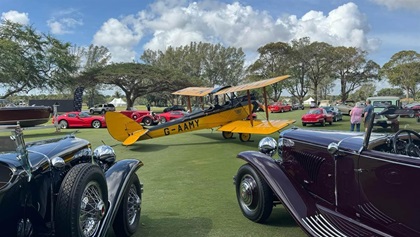The Moth whisperer
Maintaining a legend
In aviation, de Havilland enthusiasts cannot talk about their aircraft without coming across the name of Henry Labouchere.
Labouchere resides in Norfolk, England, and works on all de Havilland piston aircraft (no jets, please) and some bush aircraft such as the Cessna 180 and 185.
Moths with a capital M, as in Gipsy Moth, Tiger Moth, Hawk Moth. His is a storied life that led him from England to Australia, where he bought his Tiger Moth, to New Zealand, and several exotic locations in between. When he met his wife, he shipped his Tiger Moth and the family back to England.
Arguably the most famous Moth he’s ever worked with is the one commonly known as G-AAMY (named after Amy Johnson, the first woman to fly from England to Australia in a Gipsy Moth), the Gipsy Moth flown in the 1985 film Out of Africa. The movie won the 1986 Academy Award for best picture, and six other Oscars including one for cinematography—with much of the credit going to scenes featuring the Moth. Labouchere has taken care of G-AAMY for 40 years and helped its various owners with upkeep and maintenance. When the aircraft came up for auction earlier this year, RM Sotheby’s description of the item included Labouchere as “de Havilland Moth guru” and informed potential buyers that “he is happy to offer his services to the new owner.”
Out of Africa isn’t Labouchere's only screen work. He also flew Stearmans for the 1985 movie The Aviator with Christopher Reeve. In 1996 he decided to fly a de Havilland Dragonfly from England to EAA AirVenture in Oshkosh, Wisconsin, with his friend (and the aircraft’s owner). In a phone conversation, he recalled that when approaching Narsarsuaq, Greenland, the aircraft picked up so much ice they couldn’t see out the window. Luckily, a headwind picked up a lot of sea salt that “deiced” the aircraft on descent, so the friends landed safely and eventually made it to Oshkosh.
At the time Out of Africa was shot, he was on scene to support then-owner Cliff Lovell, who had restored the aircraft and made it available for filming, flying it in some scenes. In an email, Labouchere recalled, “At no time in the movie did it fly with two people on board, the altitude was too much and the original Wright engine (supposedly 90 hp) was fairly asthmatic.”
Said engine eventually failed at a later date in New Zealand, and Labouchere had to build up a new one, “which wasn’t much better, but was reliable.”
In 2013, G-AAMY was located in southern France and up for auction. Labouchere trucked it to Paris and reassembled it for the auction in the Grand Palais. It sold for what was then a record-breaking bid, the equivalent of about $280,000, to Jochen Zeitz, founder of the ZEITZ foundation, for his Segera Ranch in Laikipia, Kenya. In order for G-AAMY to operate at the equatorial 6,000-foot elevation, Labouchere had to rethink the engine and ended up installing a special Gipsy II capable of 132 horsepower, as well as a new Hercules propeller. He said that “this combination proved to be absolutely ideal, providing a good rate of climb.” He also attributes the good overall condition of G-AAMY to the ideal, very dry climate that does not foster rust. While it was in Kenya, Labouchere continued to take care of the aircraft, traveling there at least once a year for maintenance, inspections, and to fly visitors to the ranch around the region.
According to its website, the ZEITZ foundation is “dedicated to inspiring and achieving the highest standards in sustainability through the balance of conservation, community, culture and commerce (the 4Cs) in privately managed areas.” When Zeitz decided that he wanted to establish the Segera Rhino Sanctuary and needed funding, he knew it was time to let G-AAMY go. Labouchere flew it from the ranch to Nanyuki, where he disassembled it, shipped it to New York, and trucked it to Miami, where “lot 225” was reassembled and sold on March 2. It was then disassembled again (“I’m getting quite good at this,” quipped Labouchere in an email) and is currently awaiting shipment to its new location. Labouchere is “enormously happy” to be still involved with this iconic airplane.




